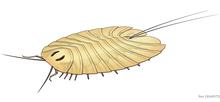Loading AI tools
Order of arthropods (fossil) From Wikipedia, the free encyclopedia
Cheloniellida is a taxon (usually referred to as an order[1][2]) of extinct Paleozoic arthropods. As of 2018,[2] 7 monotypic genera of cheloniellids had been formally described, whose fossils are found in marine strata ranging from Ordovician to Devonian in age. Cheloniellida has a controversial phylogenetic position, with previous studies associated it as either a member or relative of various fossil and extant arthropod taxa.[2] It was later accepted as a member of Vicissicaudata within Artiopoda.[3][4][5]
| Cheloniellida Temporal range: | |
|---|---|
 | |
| Restoration of Cheloniellon | |
| Scientific classification | |
| Domain: | Eukaryota |
| Kingdom: | Animalia |
| Phylum: | Arthropoda |
| (unranked): | †Artiopoda |
| (unranked): | †Vicissicaudata |
| (unranked): | †Cheloniellida Broili, 1932 |
| Genera | |
| |

The flattened, ovoid body of cheloniellid comprises an eye-bearing cephalon (head) and segmented trunk region, dorsally divided by a series of tergites (dorsal exoskeleton). The cephalon could be divided into procephalon and gnathocephalon.[2] Compared to other members of Artiopoda, the head shield (dorsal exoskeleton of cephalon) of cheloniellid is relatively reduced.[2][3] The trunk is wider than the cephalon and is made up of 8-13 tergites.[2] The pleural (lateral) tips of first few tergites are directed anterolaterally, becoming increasingly posterolaterally directed rearward, giving the segmental boundaries between tergites a radiated appearance.[3][2] The last trunk segment, also known as postabdomen,[4] is tiny and laterally encompassed by the pleural regions of previous tergite.[2]
Based on available materials, the cephalon comprises a pair of antennae and 5 pairs of uniramus appendages, with the posterior 4 pairs bore gnathobases.[6] There are evidences that the non-gnathobasic second cephalic appendages are specialized or even raptorial in some species.[6][2] Each of the trunk segments (except the last one) has a pair of biramous appendages each consisting of a leg-like endopod and a shorter exopod.[2] The last trunk segment has a pair of spine/whip-like appendages referred as furcae[3] or cerci,[6] some species bore a medial spine between it which may or may not be a telson.[2]

While Boudreaux (1979) regarded Cheloniellida as a class,[8] further studies usually treat Cheloniellida as an order.[1][2] Cheloniellida has a controversial phylogenetic position within arthropod higher classifications, with studies mainly around 20th century suggested it as a relative/member of either Crustacea, Trilobita, Chelicerata or Aglaspidida.[2] Some species even had been misidentified as polyplacophoran mollusks (chiton) when being first described.[9] Originally, the iconic cheloniellid Cheloniellon was believed to be a crustacean similar to trilobites.[10][11] Subsequent authors suggests that it occupied a position intermediate between trilobitomorphs and chelicerates,[6][7] while some also interpreted it as a sister group of crustaceans[12] or chelicerates[13][14] as well. The suggested close relationship between cheloniellids and chelicerates was inferred by the gnathobasic appendages similar to those of merostomes (e.g. Xiphosurans and Eurypterids), and the hypothesis that the chelicerates arose from trilobitomorphs through the loss of deutocerebral antennae (i.e. first antennae) and specialization of tritocerebral appendages into chelicerae (comparable to the cheloniellid antennae and specialized 2nd appendages),[6][7] a scenario which is not supported by gene expression,[15][16][17][18][19] neuroanatomical[20][21] and developmental[22] evidences (suggests that chelicerae are in fact deutocerebral).
| ||||||||||||||||||||||||||||||||||||||||||||||||||||||||||||||||||||||||||||||||||||||||||
| Summarized phylogeny of Artiopoda with focus on Cheloniellida, based on Lerosey-Aubril et al. (2017).[4] |
As of 21st century, Cheloniellida was mostly found to form a clade with Aglaspidida and Xenopoda (e.g. Sidneyia and Emeraldella).[23][3][24][25][4] The clade was formally named Vicissicaudata in 2013,[3] united by a differentiated terminal trunk area (postabdomen) that bears a pair of non-leg-like appendages.[3][4] Numerous phylogenetic analyses also retrieved Vicissicaudata within Artiopoda,[4] a diverse arthropod taxon comprising trilobites and similar fossil taxa that may[26][24] or may not[3][25][4] be closely related to chelicerates.
The unambiguous members of cheloniellids shown as follows:
In 2018, a new species (informally named "Latromirus" in an unpublished thesis from 2016[27]) was described in a preprint by Wendruff et al.[2] According to Braddy & Dunlop 2021, the enigmatic Parioscorpio may have cheloniellid affinities,[28] however that interpretation is denied by Van Roy et al. 2022, only remaining specimen UWGM 2439 (holotype specimen of "Latromirus") as possible cheloniellid.[29]
Seamless Wikipedia browsing. On steroids.
Every time you click a link to Wikipedia, Wiktionary or Wikiquote in your browser's search results, it will show the modern Wikiwand interface.
Wikiwand extension is a five stars, simple, with minimum permission required to keep your browsing private, safe and transparent.